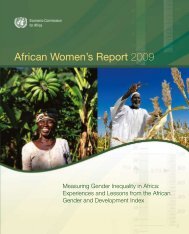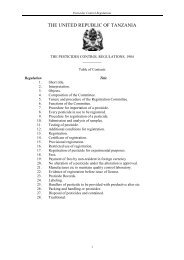Community-driven development decision tools for rural - IFAD
Community-driven development decision tools for rural - IFAD
Community-driven development decision tools for rural - IFAD
- No tags were found...
You also want an ePaper? Increase the reach of your titles
YUMPU automatically turns print PDFs into web optimized ePapers that Google loves.
• ways to make clear that these are the yardsticks against which staff and managers’per<strong>for</strong>mance will be measured and evaluated;• the behaviour that project staff and managers should adopt with their partners at thecommunity and local government levels.Project targets are rooted in the design of a project. If design reports are vague about theproject’s CDD objectives, management targets set at the beginning of implementation either willbe very general with respect to those objectives or simply ignored. In these cases,implementation practices invariably sideline the more complex objectives (e.g. the institutional<strong>development</strong> of the CBOs) and concentrate on the easier objectives, which are those connectedwith achieving physical targets, particularly “visible” infrastructure. Using definitions adopted by<strong>IFAD</strong>’s RIMS, this leads to concentrating the M&E system on the project output, a level far awayfrom third-level results.It is there<strong>for</strong>e important that project appraisal reports link the CDD objectives of a projectwith clearly defined per<strong>for</strong>mance indicators and that such indicators be agreed upon during loannegotiations and subsequently used in designing the M&E system of the project. A list of possibleindicators is presented in Box 40.M&E systems’ ability to monitor progress on CDD objectivesThe function of the M&E system is to monitor the progress of project implementation and itscon<strong>for</strong>mity with project objectives. In principle, the design of the system should start from aprecise definition of the major indicators of project per<strong>for</strong>mance. The RIMS method ofconstructing project logical frameworks emphasizes the impact of the project (i.e. the “third-levelresults”). Since the most critical CDD objectives are at the third level of results, the M&E systemmust be able to focus on project impact in order <strong>for</strong> M&E activities to be useful in shaping thesystem of incentives that confronts the key actors in project implementation.<strong>IFAD</strong>’s experience, which is shared by several other <strong>development</strong> agencies, is that while M&Eunits are generally good reporting project output, they are less successful in reporting aboutoutcomes because in<strong>for</strong>mation on project impact is not always collected. This may be due to thebelief, widespread among local M&E officers and not without some justification, that impact issomething that can be assessed only at the end of a project. At that point they think it is too lateto survey the situation be<strong>for</strong>e the project accounts are closed or to have any effect on projectBox 40Suggested general indicators of CDDper<strong>for</strong>mance• the quality of the partnerships establishedwith project support, including the relationsbetween the CBOs, the different layers of thepublic administration, the civil society and theprivate sector;• the institutional <strong>development</strong> achieved by thecommunities, in terms of the working of theCBOs’ own internal rules;• roles, attitudes, expectations and motivationsof the emergent community leaders (i.e.within their communities and beyond thecommunity, including unions of CBOs, thepolitical arena and CSOs);• noticeable changes in the culture ofthe communities that enhance dynamismand self-help;• changes in the organizational culture of thegovernment and non-governmentalorganizations with respect to the roleof CBOs;• actual changes in the institutional setting thatconfronts the CBOs;• the impact of the CBOs on improving thelocal governance system;• evolution in the role of women and othernon-dominant members of the communities;• distribution of project benefits and theirimpact on the social stratification within thecommunities;• achievements of CBOs and unions of CBOson reducing the impact of market failures thataffect the livelihood of their members.80
















